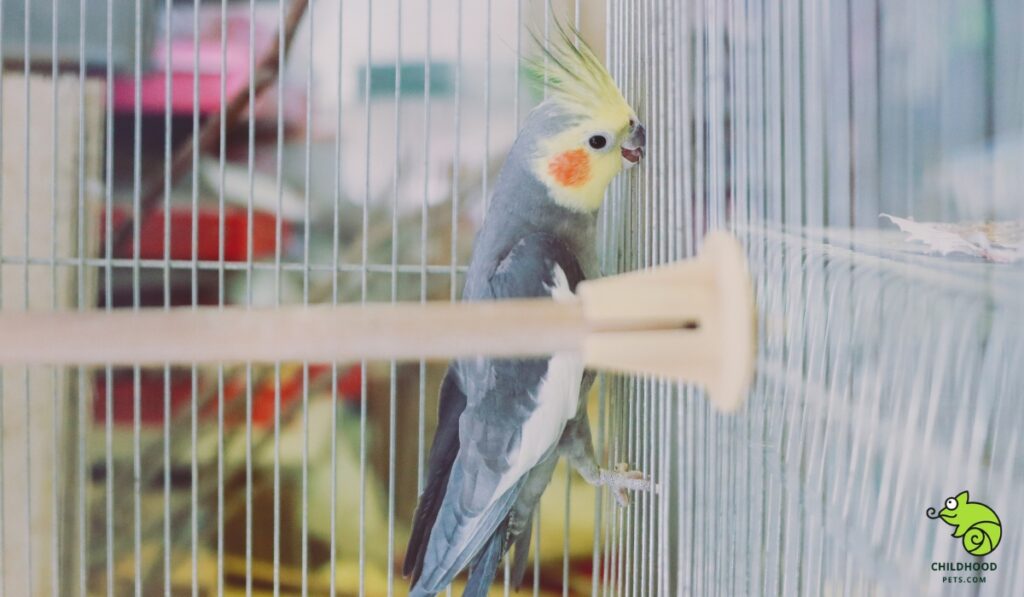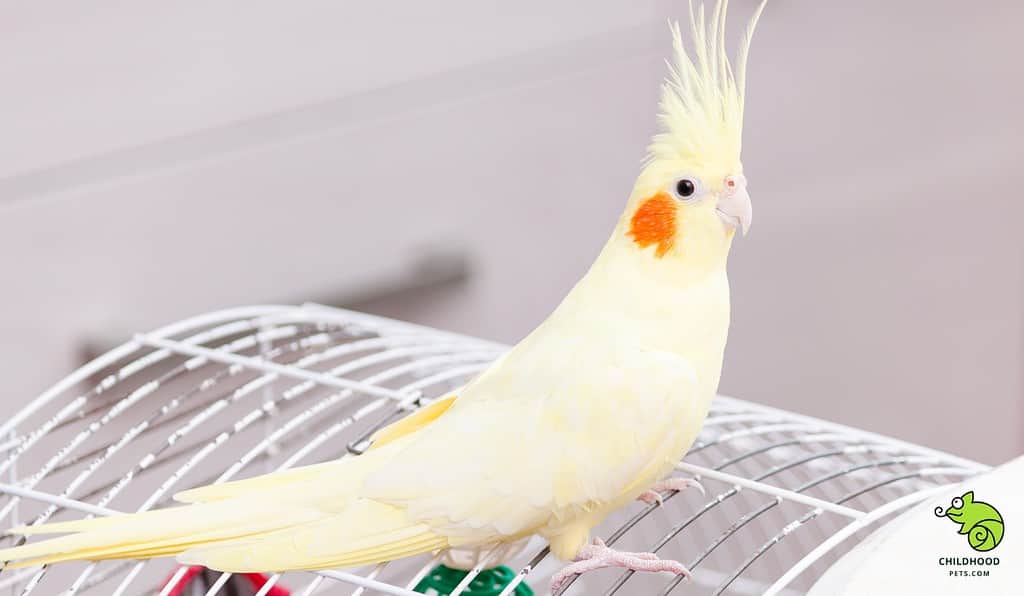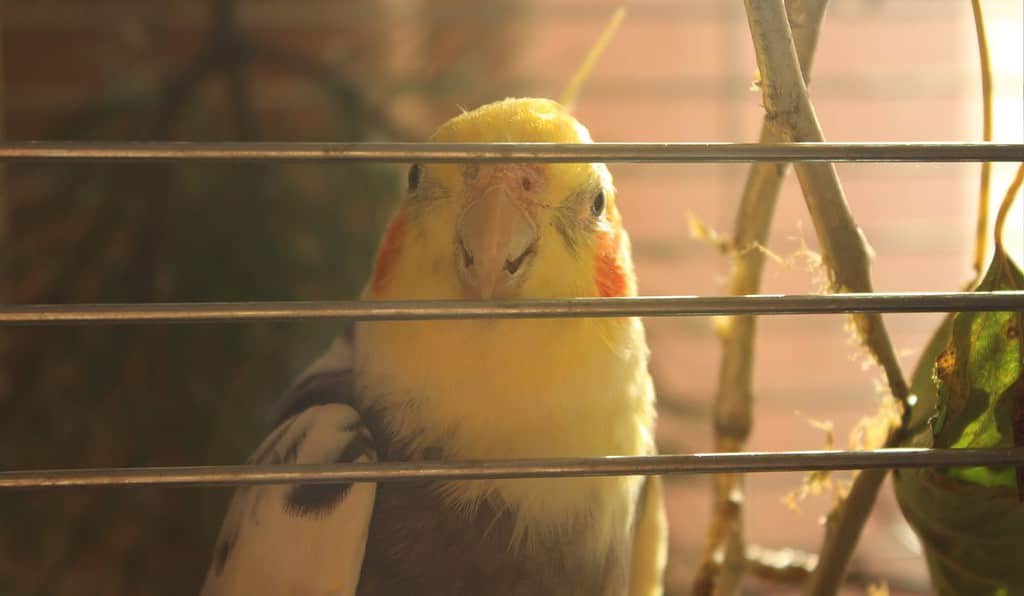
Cockatiels, with their vibrant personalities and melodic chirps, have become one of the most beloved pets worldwide. But did you know that the size and placement of their cage can significantly impact their health and happiness? It’s not just about giving them a space; it’s about providing them with a home that caters to their unique needs.
As a general rule, the optimal cage size for a cockatiel should be large enough to allow them to spread their wings and move freely. This typically means a cage that’s at least 24 inches wide, 24 inches deep, and 24 inches tall.
Ready to dive deeper? Whether you’re a seasoned bird owner or just starting your journey, this guide will provide you with all the insights you need to ensure your feathered friend has the perfect abode. Let’s take flight and explore the world of cockatiel cages!
Why Cockatiels Need a Proper Cage
A cage plays a pivotal role in a cockatiel’s life. Think of it as their personal sanctuary—a place where they eat, sleep, play, and feel safe. While we all love the idea of our birds flying freely around the house, it’s essential to provide them with a space they can call their own. This balance between freedom and safety is crucial. Just as we humans need our private space to retreat and rejuvenate, cockatiels too need their own little haven.
How Big Should a Cockatiel Cage Be?
Before diving into the specifics, it’s essential to understand that the size of the cage directly influences your bird’s quality of life. Let’s delve into the details.
Single Cockatiel
For those of you with a single cockatiel, the cage dimensions are crucial. Based on my experience and research:
Minimum dimensions for a single bird:
| Cockatiel Feature | Measurement |
| Height | 24 inches |
| Width | 24 inches |
| Length | 24 inches |
| Wingspan | Up to 12 inches |
It’s vital to ensure that the cage is at least 1.5 to 2 times the total wingspan of the bird. Given that cockatiels can have a wingspan of up to 12 inches, the dimensions mentioned above are the bare minimum. Remember, a spacious cage allows your bird to remain active, stretch its wings, and engage in natural behaviors.
Cage Size for 2 Cockatiels
If you’re blessed with a pair of these chirpy companions, here’s what you need to know:
Recommended dimensions for housing two cockatiels:
- Height: 36 inches
- Width: 24 inches
- Length: 24 inches
Benefits of housing two cockatiels together:
- Companionship: Cockatiels are inherently social creatures. Having a companion ensures they have someone to interact with, reducing feelings of loneliness.
- Mental Stimulation: Two birds will engage in mutual grooming, play, and communication, keeping them mentally stimulated.
- Shared Warmth: Especially during colder months, two birds can snuggle up and share warmth.
- Learning from Each Other: Whether it’s a new song or a trick, cockatiels often learn by observing their peers.
- Potential for Breeding: If you have a male and female pair, there’s always the exciting possibility of baby cockatiels in the future!
Understanding the social nature of cockatiels is essential. They thrive on interaction, whether with their human caregivers or their feathered friends. Having a pair not only provides them with constant companionship but also enriches their lives in numerous ways. So, if you’re considering getting a cockatiel, maybe think about getting two! They’ll keep each other company when you’re not around, and you’ll have double the fun watching their antics.
Specialized Cages

As we delve deeper into the world of cockatiels, it’s essential to understand that not all cages are created equal. Depending on your bird’s needs and your specific circumstances, there are specialized cages designed to cater to various situations. Let’s explore these unique habitats and their purposes.
Flight Cages for Cockatiels
Flight cages, as the name suggests, are designed to give our feathered friends ample space to spread their wings and fly. These cages are particularly beneficial for cockatiels, known for their active nature and love for flying. By providing them with a flight cage, you’re essentially gifting them a slice of the wild, right in the comfort of your home.
For those considering indoor aviaries, a size of 27 inches in width and 24 inches in length is recommended. However, if you’re fortunate enough to have outdoor space and are thinking of setting up an outdoor aviary, aim for a width of 4 feet, a length of 12 feet, and a height of 8 feet. This ensures your cockatiels have ample space to indulge in their natural flying instincts.
Travel Cages
Whether you’re visiting the vet, going on a vacation, or simply taking your cockatiel to a friend’s house, travel cages come in handy. These cages are designed to be compact, lightweight, and secure, ensuring your bird’s safety during transit. A typical travel cage for cockatiels would be around 12 inches in width and height.
Tips for traveling with a cockatiel:
- Acclimatize Before the Journey: Before embarking on a long journey, let your cockatiel spend short durations in the travel cage to get accustomed to it.
- Keep the Cage Stable: Ensure the cage is securely placed in your vehicle to prevent unnecessary movement.
- Stay Calm and Talk to Your Bird: Your voice can be a source of comfort for your cockatiel during travel.
- Hydration is Key: Ensure your bird has access to fresh water throughout the journey.
- Avoid Direct Sunlight: Place the cage in a spot where it’s shielded from direct sunlight to prevent overheating.
Cockatiel Cage for a Breeding Pair
Breeding is a beautiful phase in a bird’s life, and having the right cage can make a world of difference. For a breeding pair of cockatiels, a cage with a width of 20 inches, a depth of 20 inches, and a height of 50 inches is ideal. This provides enough space for the birds to move around and for the addition of a nesting box.
Horizontal space is of utmost importance in breeding cages. It allows the birds to fly side by side, strengthening their bond. Moreover, it provides ample room for the chicks once they hatch, ensuring they have enough space to grow and thrive.
So, whether you’re a seasoned bird enthusiast or someone just starting on this journey, understanding the nuances of specialized cages can significantly enhance your cockatiel’s quality of life. After all, a happy bird means a happy you!
Essential Features of a Cockatiel Cage

While the size of a cockatiel cage is undeniably crucial, the features within the cage play an equally significant role in ensuring your bird’s happiness and well-being. Let’s dive into the nitty-gritty of what makes a cockatiel cage truly exceptional.
Bar Spacing
The spacing between the bars of a cockatiel cage is more than just an aesthetic choice; it’s a safety concern. Ideally, bar spacing should be up to ½ inches. Any wider, and you run the risk of your cockatiel attempting to squeeze through, potentially causing injury or even escape. On the flip side, bars that are too close together can restrict airflow and visibility, making the cage feel more like a prison than a home.
Material
The material of the cage is paramount for both durability and the safety of your feathered friend. Here are some common cage materials and their pros and cons:
Stainless Steel:
- Pros: Rust-resistant, durable, non-toxic.
- Cons: Can be pricier than other materials.
Powder-Coated Metal:
- Pros: Resistant to rust, available in various colors, more affordable than stainless steel.
- Cons: Birds with a habit of chewing might chip the coating, potentially ingesting harmful substances.
Galvanized Steel (before welding):
- Pros: Affordable.
- Cons: Can rust over time, potential zinc poisoning if the bird chews on it.
Plastic:
- Pros: Lightweight, easy to clean.
- Cons: Not as durable, birds can chew and break it.
Wood:
- Pros: Natural look, can be chewed without harm.
- Cons: Harder to clean, can harbor mites or bacteria.
When choosing a material, always prioritize your bird’s safety. Remember, what might work for one bird might not be suitable for another, especially if they have a habit of chewing on their cage.
Cleaning and Maintenance
A clean cage is a happy cage! Slide-out trays at the bottom of the cage can be a game-changer, making daily cleaning routines a breeze. By simply sliding out the tray, you can remove waste and uneaten food without disturbing your bird.
Steps for a weekly cleaning routine:
- Remove Your Bird: Place your cockatiel in a safe, temporary cage.
- Slide Out the Tray: Dispose of the waste and wash the tray with warm soapy water.
- Clean the Bars: Using a bird-safe disinfectant, wipe down the bars of the cage.
- Wash Food and Water Bowls: Ensure they’re free from any leftover food or debris.
- Inspect Toys and Accessories: Check for any signs of wear and tear.
- Sweep or Vacuum Around the Cage: This keeps the surrounding area clean.
- Return Your Bird: Once everything is dry and clean, place your cockatiel back in its cage.
Food and Water Arrangements
The placement of food and water bowls is more strategic than you might think. Ideally, they should be placed at the height of your bird’s chest. This position encourages movement as your cockatiel will climb to access its food and water. Additionally, placing bowls away from perches reduces the chances of contamination from droppings.
Accessories
Toys aren’t just for fun; they’re essential for your cockatiel’s mental stimulation. Here are some recommended toys and their benefits:
- Chew Toys: Helps in beak trimming and provides a fun activity.
- Mirrors: Cockatiels are social birds and often enjoy interacting with their reflection.
- Swings and Ladders: Encourages physical activity and climbing.
- Bells and Rattles: Provides auditory stimulation.
- Foraging Toys: Mimics the act of searching for food, providing both mental and physical stimulation.
In addition to toys, consider adding various perches and climbing materials. Different textures and diameters of perches can help in foot exercise and prevent arthritis in the long run.
In essence, setting up the perfect environment for your cockatiel goes beyond just buying a cage. It’s about creating a space where they feel safe, entertained, and loved. With the right features and regular maintenance, you’re not just giving them a cage; you’re giving them a home.
Cockatiel Cage Placement

Finding the perfect cage is just the beginning. Where you place that cage in your home can make a world of difference to your cockatiel’s happiness and well-being. It’s like choosing between a room with a view or one facing a brick wall. Let’s explore the best spots and what to avoid.
Potential hazards to avoid when placing a cage:
- Direct Sunlight: While cockatiels love a bit of sun, prolonged exposure can cause overheating.
- Drafts: Avoid placing the cage near windows or doors where there might be drafts.
- Kitchen: Fumes from cooking can be harmful. Plus, there’s the risk of hot splatters.
- Toxic Plants: Some household plants can be harmful if ingested.
- High Traffic Areas: Constant movement can stress out your bird.
When considering cage placement, always prioritize safety. A spot that allows your cockatiel to socialize with the family, without being in the midst of chaos, is ideal. Remember, a well-placed cage promotes bird well-being, ensuring they feel both secure and engaged with their surroundings.
Cost of Cockatiel Cages
The saying “you get what you pay for” often rings true when it comes to cockatiel cages. But understanding the price range and what features come with it can help you make an informed decision.
| Cage Type | Features | Price Range (USD) |
| Standard Cage | Basic design, adequate space | $50 – $150 |
| Premium Cage | Enhanced durability, additional features | $150 – $500 |
| Flight Cage | Ample space for flying | $100 – $400 |
| Travel Cage | Compact, lightweight | $30 – $100 |
| Breeding Cage | Designed for breeding pairs, nesting space | $100 – $300 |
While the table provides a general overview, prices can vary based on brand, material, and additional features. It’s always a good idea to invest in quality, ensuring your bird’s home is both durable and safe.
DIY Cockatiel Cages: Pros and Cons
For the hands-on bird owners out there, building a DIY cage might sound appealing. But before you dive in, let’s consider the essentials.
Materials needed for a DIY cage:
- Sturdy Frame: Typically made of wood or metal.
- Safe Wiring: Ensure the wire is non-toxic and has the appropriate bar spacing.
- Slide-out Tray: For easy cleaning.
- Lockable Door: Safety first!
- Perches and Accessories: To make the cage comfortable and engaging.
While going the DIY route can be cost-effective and allows for customization, it also requires a fair bit of expertise. Ensuring the cage is safe, secure, and suitable for your cockatiel is paramount. If you’re not entirely confident, it might be best to stick with a store-bought option.
Conclusion
Choosing and setting up the perfect environment for your cockatiel is a labor of love. It’s about understanding their needs, ensuring their safety, and providing them with a space where they can thrive. As a vet, I’ve seen the difference the right cage can make in a bird’s life. I hope this guide has shed some light on the intricacies of cockatiel cages. I’d love to hear your thoughts, experiences, and any tips you might have. And if you found this article helpful, don’t hesitate to share it with fellow bird enthusiasts!
